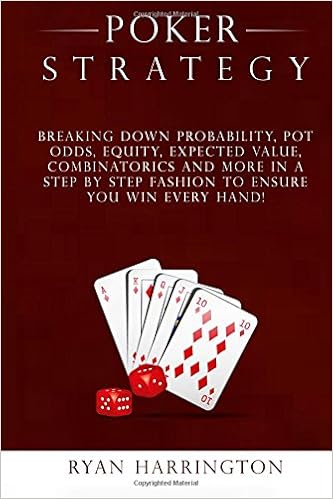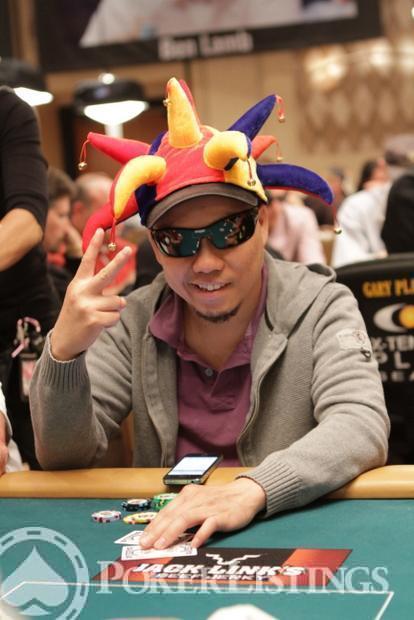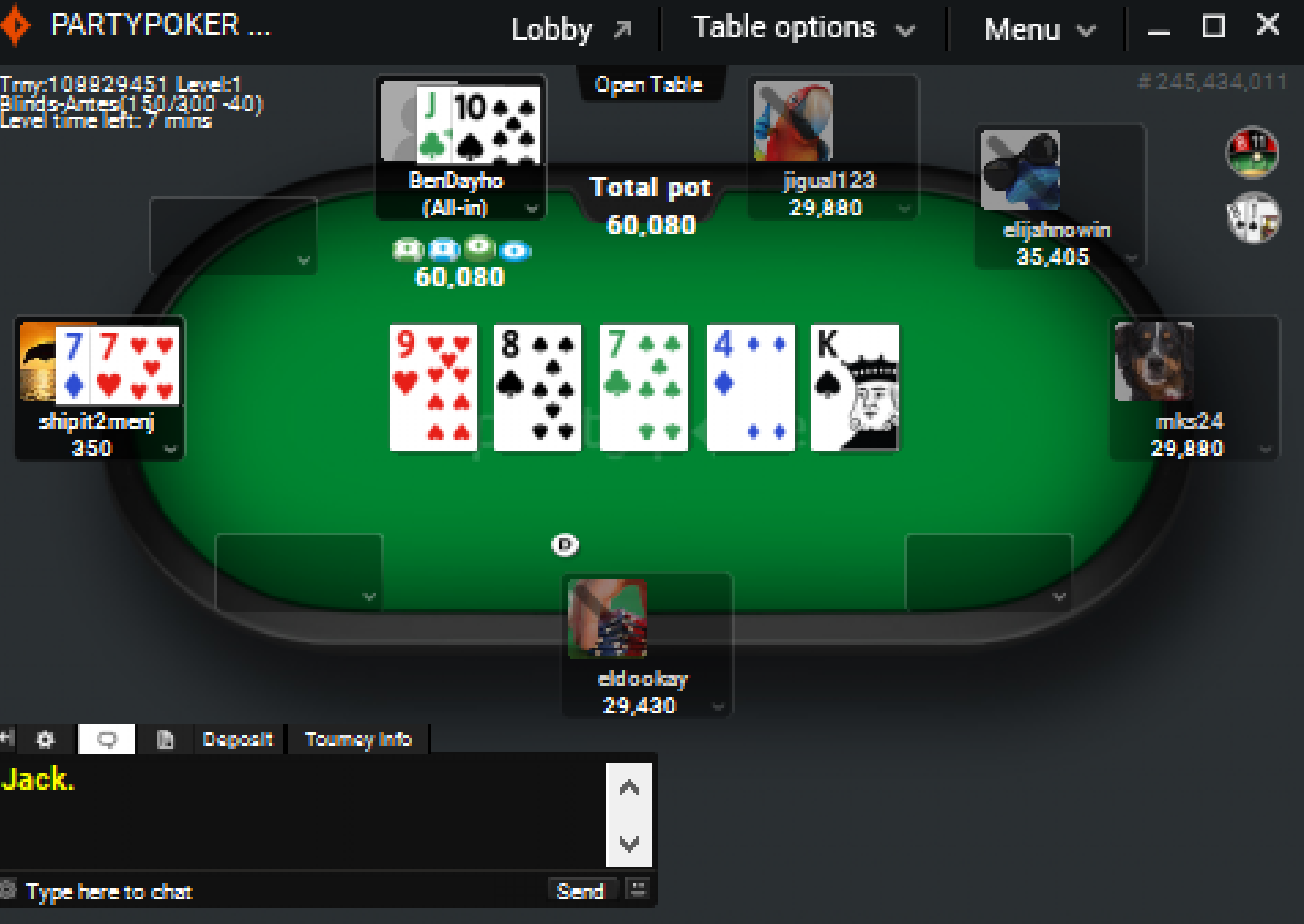Well, I'm hoping this article will help answer that question and provide some much needed perspective on the topics of volume and variance. Amateur Poker Players vs. Pros Amateurs – For the purpose of this article, an amateur player is someone who plays about 1-3 times per week, usually at night. Re: low variance live poker anyone? Well, it seems many just want to take the poker variance as a 'given' and win rate as the only variable and objective to pursue. To them, advocating embracing variance is the only way to go with only the stakes as a variable to manage bankroll, moving to lower stakes to diminish the absolute $ level of.
- Variance In Live Poker Odds
- Variance In Live Poker Deuces Wild
- Variance In Live Poker Tournaments
- Variance In Live Poker Games
Do you get frustrated playing poker tournaments? You play all the time and it seems like you never cash. And even when you do, you cash the minimum. Every once in a while you get teased with a deep run only to run Kings into Aces – resulting in another broken mouse.

Well as you gain experience, you learn that in order to be successful as a poker player you need to get comfortable with running bad. This is even more prevalent if you are a poker tournament specialist. But no matter how experienced you are, these bad runs can test you and make you question your skill level. This is especially true if you are an amateur poker player who only plays a handful of tournaments a week. You can actually go months without cashing and this duration of time in between cashes can skew your view of reality and affect your play.
Now if you read enough poker forums and websites you will hear about all the online tournament pros who are regularly taking down five and six-figure cashes. They paint this picture of guys constantly making final tables and raking in mounds of cash. You may even be a bit jealous and wonder, 'what do those guys have that I don't?' Well, I'm hoping this article will help answer that question and provide some much needed perspective on the topics of volume and variance.
Amateur Poker Players vs. Pros
Amateurs – For the purpose of this article, an amateur player is someone who plays about 1-3 times per week, usually at night. They have a 'real job' and may have a family or are in college full time, so they can only put in part-time hours. But make no mistake, this player is serious about the game and spends time on poker forums, watching training videos, etc. Since we're talking about tournament poker, the amateur in this article plays mostly large field no-limit hold'em tournaments. They may be a winning player, break even or maybe a slight loser in the game thus far in their career.
Pros – A professional is someone who plays online poker for their sole source of income. For this article, we are using those who specialize in large field online poker tournaments.
The Stats
Before reading too deep into these numbers, keep in mind that the purpose of this article is to provide perspective into your own results by comparing them to the results of other players. It is not meant to be a scientific study.
The numbers below represent an average of 10 players from each category and use results from both Full Tilt Poker and PokerStars from 2010. The pro stats were taken from 1/1/10 until 8/22/10 and the amateur stats were taken from 1/1/10 until 9/20/10. They only include tournaments with over 180 players.
| Pros* | Amateurs* | |
| # Played | 3557 | 661.5 |
| Avg Played/Day** | 21.5 | 3.58 |
| In the Money | 13.10% | 15.7% |
| Final Tables | 3.13% | 2% |
| Top 3 | 1.36% | 0.54% |
| Top 3 when at Final Table | 43.61% | 28.09% |
| Wins | 0.73% | 0.22% |
| ROI | 77.65% | 19.68% |
| Longest Non-Cash Streak | 47 | 22.5 |
* Pro stats were taken from a ranking of the top 10 online tournament players. Amateur stats were taken from a sample of 10 amateur players who volunteered their screen name for use in this study.
**Avg. Played/Day is based on a 5 day week, but also only includes playing 2 sites. Actual volume per day may be larger for those who play more than 2 sites and less than 5 days a week.
What Do These Stats Mean?
As you can see, the pros are not these mythical beasts who cash all the time and final table every tournament. Media attention can sometimes give off a false reality as it only highlights their wins and never mentions how many losses it took to get there.

The realities are:
- Even the top pros only win tournaments less than 1% of the time. For some it was as low as 0.60%. So this means they are winning only 1 out of every 100 times. Of course variance doesn't always come on schedule and they can go 200-300 tournaments without a win.
- Top pros only final table around 3% of the time. Some are as low as 2%.
- Top pros are only cashing about 13% of the time. This means they lose money 87% of the time they play! In fact, amateurs cash more often than pros. The difference is that when pros do cash, they cash deep more often.
- Pros have massive downswings like everyone else. In fact, becasue of the volume they play, they have had longer non-cash streaks.
Why have the pros averaged a $400,000 profit this year before September? It is in their ability to close tournaments. There is a reason why their ROI is 58% higher. Let's look at the stats:
- Pros make 1/3 more final tables than amateur poker players.
- At a 9 person final table, the average of hitting top 3 should be 33%. Pros are hitting this 43.61% of the time.
- Of the times they cash, pros are final tabling almost twice as often as amateurs (23.9% compared to 12.8%).
- Pros finish in the top 3 almost 3x as often as amateurs.
- Volume, volume, volume. Let's not forget that pros play all day, every day. This is their job. They have a distinct advantage of overcoming bad variance much quicker and also seeing 'the long run' of making profitable decisions quicker.
Keep in mind that the group of amateurs used were volunteers from various poker forums. While not all were winning players, the fact that they study the game says they likely have better results than an average amateur. Also, because of their volume size an individual amateur's skills may be better or worse than their results show.
Improving Your Game
How can you use these stats to improve your game?
Add More Tables
Get outside of your 1-3 tabling comfort zone and simply add a couple more tables. I know the argument is that it's harder to make reads, but the volume you put in will make up for that. In addition, this extra volume means you are playing more hands and will result in improving your game even faster. This extra experience will more than make up for the short-term loss of a perfect read.
Play More Days
Just try to add 1 more day per week. Don't be lazy. If you currently play 7 tournaments a day, adding 1 more day x 52 weeks = 364 more tournaments/year. Even at the amateur ROI average above of 20% and average buy-in of $30, that means an extra $2,184 in profit.
Stop Caring About Individual Tournaments
It's easy to expend emotional energy in any single poker tournament. You're trying to win of course. But the odds are that you're not going to. In fact, you're only going to cash about 15% of the time. All you can do is focus on making good decisions and the variance will work itself out in the end.
Play for the Win
There's a reason why amateurs cash more than pros. They care more about it and tighten up near the bubble. But you will miss out on valuable opportunities to accumulate chips if you are playing just to cash. In addition, you can't fear busting or making a mistake when you get deep. In order to make real money playing poker tournaments, you have to trust your instincts and play to win.
If you've ever grown frustrated playing poker tournaments, don't sweat it. Keep in perspective that even the best players in the world don't win that often. The only way to balance out negative variance is to put in enough volume where your skill can prevail.
Good luck at the tables.
Related Articles
By Donovan Panone
Donovan started playing poker in 2004 and is an experienced tournament and cash game player who has a passion for teaching and helping others improve their game.
Great, revealing article. Stats like these are very encouraging. Thanks, Donovan
Leave a Reply
You must be logged in to post a comment.
Live poker has variance just like any other form of poker.
The thing about live poker variance is that it's much slower
and prolonged than what you'll normally encounter in online
play. With online poker, a player can swing up or down 5-10 buy
ins in a single day. These types of swings are very uncommon in
live poker due to the much slower pace of the game. Depending on
the type of game that you play, your skill level, your style of
play, and what limit you play, your live poker variance can mean
small swings on a monthly basis or huge swings on a weekly
basis.


Live poker players tend to worry much more about their swings
than they really should, and this is a product of the environment.
When you are playing poker online, you don't really have
the money in your hands. You don't feel the losses as much
because everything is virtual. In live poker, however, a buy in
lost means you need to reach into your pocket for another $200,
$500 or $1,000+. These types of losses are very real and
will affect almost any player.
Variance at $1/$2 NLHE Games
In NLHE games you are always going to run into more variance
than what you'll find in limit games, and for very obvious
reasons.
Variance In Live Poker Odds

Well as you gain experience, you learn that in order to be successful as a poker player you need to get comfortable with running bad. This is even more prevalent if you are a poker tournament specialist. But no matter how experienced you are, these bad runs can test you and make you question your skill level. This is especially true if you are an amateur poker player who only plays a handful of tournaments a week. You can actually go months without cashing and this duration of time in between cashes can skew your view of reality and affect your play.
Now if you read enough poker forums and websites you will hear about all the online tournament pros who are regularly taking down five and six-figure cashes. They paint this picture of guys constantly making final tables and raking in mounds of cash. You may even be a bit jealous and wonder, 'what do those guys have that I don't?' Well, I'm hoping this article will help answer that question and provide some much needed perspective on the topics of volume and variance.
Amateur Poker Players vs. Pros
Amateurs – For the purpose of this article, an amateur player is someone who plays about 1-3 times per week, usually at night. They have a 'real job' and may have a family or are in college full time, so they can only put in part-time hours. But make no mistake, this player is serious about the game and spends time on poker forums, watching training videos, etc. Since we're talking about tournament poker, the amateur in this article plays mostly large field no-limit hold'em tournaments. They may be a winning player, break even or maybe a slight loser in the game thus far in their career.
Pros – A professional is someone who plays online poker for their sole source of income. For this article, we are using those who specialize in large field online poker tournaments.
The Stats
Before reading too deep into these numbers, keep in mind that the purpose of this article is to provide perspective into your own results by comparing them to the results of other players. It is not meant to be a scientific study.
The numbers below represent an average of 10 players from each category and use results from both Full Tilt Poker and PokerStars from 2010. The pro stats were taken from 1/1/10 until 8/22/10 and the amateur stats were taken from 1/1/10 until 9/20/10. They only include tournaments with over 180 players.
| Pros* | Amateurs* | |
| # Played | 3557 | 661.5 |
| Avg Played/Day** | 21.5 | 3.58 |
| In the Money | 13.10% | 15.7% |
| Final Tables | 3.13% | 2% |
| Top 3 | 1.36% | 0.54% |
| Top 3 when at Final Table | 43.61% | 28.09% |
| Wins | 0.73% | 0.22% |
| ROI | 77.65% | 19.68% |
| Longest Non-Cash Streak | 47 | 22.5 |
* Pro stats were taken from a ranking of the top 10 online tournament players. Amateur stats were taken from a sample of 10 amateur players who volunteered their screen name for use in this study.
**Avg. Played/Day is based on a 5 day week, but also only includes playing 2 sites. Actual volume per day may be larger for those who play more than 2 sites and less than 5 days a week.
What Do These Stats Mean?
As you can see, the pros are not these mythical beasts who cash all the time and final table every tournament. Media attention can sometimes give off a false reality as it only highlights their wins and never mentions how many losses it took to get there.
The realities are:
- Even the top pros only win tournaments less than 1% of the time. For some it was as low as 0.60%. So this means they are winning only 1 out of every 100 times. Of course variance doesn't always come on schedule and they can go 200-300 tournaments without a win.
- Top pros only final table around 3% of the time. Some are as low as 2%.
- Top pros are only cashing about 13% of the time. This means they lose money 87% of the time they play! In fact, amateurs cash more often than pros. The difference is that when pros do cash, they cash deep more often.
- Pros have massive downswings like everyone else. In fact, becasue of the volume they play, they have had longer non-cash streaks.
Why have the pros averaged a $400,000 profit this year before September? It is in their ability to close tournaments. There is a reason why their ROI is 58% higher. Let's look at the stats:
- Pros make 1/3 more final tables than amateur poker players.
- At a 9 person final table, the average of hitting top 3 should be 33%. Pros are hitting this 43.61% of the time.
- Of the times they cash, pros are final tabling almost twice as often as amateurs (23.9% compared to 12.8%).
- Pros finish in the top 3 almost 3x as often as amateurs.
- Volume, volume, volume. Let's not forget that pros play all day, every day. This is their job. They have a distinct advantage of overcoming bad variance much quicker and also seeing 'the long run' of making profitable decisions quicker.
Keep in mind that the group of amateurs used were volunteers from various poker forums. While not all were winning players, the fact that they study the game says they likely have better results than an average amateur. Also, because of their volume size an individual amateur's skills may be better or worse than their results show.
Improving Your Game
How can you use these stats to improve your game?
Add More Tables
Get outside of your 1-3 tabling comfort zone and simply add a couple more tables. I know the argument is that it's harder to make reads, but the volume you put in will make up for that. In addition, this extra volume means you are playing more hands and will result in improving your game even faster. This extra experience will more than make up for the short-term loss of a perfect read.
Play More Days
Just try to add 1 more day per week. Don't be lazy. If you currently play 7 tournaments a day, adding 1 more day x 52 weeks = 364 more tournaments/year. Even at the amateur ROI average above of 20% and average buy-in of $30, that means an extra $2,184 in profit.
Stop Caring About Individual Tournaments
It's easy to expend emotional energy in any single poker tournament. You're trying to win of course. But the odds are that you're not going to. In fact, you're only going to cash about 15% of the time. All you can do is focus on making good decisions and the variance will work itself out in the end.
Play for the Win
There's a reason why amateurs cash more than pros. They care more about it and tighten up near the bubble. But you will miss out on valuable opportunities to accumulate chips if you are playing just to cash. In addition, you can't fear busting or making a mistake when you get deep. In order to make real money playing poker tournaments, you have to trust your instincts and play to win.
If you've ever grown frustrated playing poker tournaments, don't sweat it. Keep in perspective that even the best players in the world don't win that often. The only way to balance out negative variance is to put in enough volume where your skill can prevail.
Good luck at the tables.
Related Articles
By Donovan Panone
Donovan started playing poker in 2004 and is an experienced tournament and cash game player who has a passion for teaching and helping others improve their game.
Great, revealing article. Stats like these are very encouraging. Thanks, Donovan
Leave a Reply
You must be logged in to post a comment.
Live poker has variance just like any other form of poker.
The thing about live poker variance is that it's much slower
and prolonged than what you'll normally encounter in online
play. With online poker, a player can swing up or down 5-10 buy
ins in a single day. These types of swings are very uncommon in
live poker due to the much slower pace of the game. Depending on
the type of game that you play, your skill level, your style of
play, and what limit you play, your live poker variance can mean
small swings on a monthly basis or huge swings on a weekly
basis.
Live poker players tend to worry much more about their swings
than they really should, and this is a product of the environment.
When you are playing poker online, you don't really have
the money in your hands. You don't feel the losses as much
because everything is virtual. In live poker, however, a buy in
lost means you need to reach into your pocket for another $200,
$500 or $1,000+. These types of losses are very real and
will affect almost any player.
Variance at $1/$2 NLHE Games
In NLHE games you are always going to run into more variance
than what you'll find in limit games, and for very obvious
reasons.
Variance In Live Poker Odds
Variance In Live Poker Deuces Wild
The lowest stakes No Limit games will have the lowest
long term swings due to:
- The overall skill levels of players
- Weak or new to the live poker scene
- Non serious players just playing for fun
Don't expect to run into a whole lot of deep thinking players in these
games. As a result of all of this, you should not have many big
down swings.
Normal Swing Range for $1/$2 NLHE
Most $1/$2 NLHE players will have normal swings in the range
of 1-3 buy ins. Though 5 buy in swings are definitely going to
happen from time to time, they aren't all that common. It's
unlikely that you'll frequently lose more than this if you are
a sound winning player. If you are going on bigger swings than
this at $1/$2, you may want to re-think your live poker strategy
altogether. In the end, it gets no easier than this limit when
it comes to live poker.
Variance In Live Poker Tournaments
Variance at $2/$5 and $5/$10 NLHE Games
These two limits were lumped together, though they most
definitely could be separated. The reality is that a very small
percentage of the live poker population makes $5/$10 their
regular game for a number of reasons.
- There aren't many casinos with a $5/$10 or higher No Limit Texas Hold'em
- Casinos are loaded with $1/$2 tables and the sparse $2/$5 table
- Only a couple casinos in these locations will have $5/$10 running at most times of the day
If you play in Atlantic City, Las Vegas, California, or Florida,
you'll find some exceptions to this rule.
Normal Swing Range for $2/$5 & $5/$10 NLHE
In these games, swings of 1-5 buy ins are the norm. The live
poker variance will always increase as you play higher limit games
and games with tougher levels of opponents. Variance is going to
be diminished from the perspective of buy ins when you are
playing in deeper games. For example, a $1000 max game at $2/$5
will have less buy in variance than a $500 max $2/$5 game. This
is because many players will buy in short and for under the max
which will make it more unlikely that you will be in 2k+ pots.
Dealing with Live Poker Variance
One of the biggest adjustments and learning curves for new
live poker players is being able to adapt to the constant swings
of real money. You'll likely be thinking about just how long
it is going to take for you to recoup those losses. Because live
poker is slow, you'll be left with even more time to bemoan
your losses and to contemplate how just one faded flush card
would have turned your night around. In live poker it's even
more important that you are able to let the losses roll off your
back.
Variance In Live Poker Games
A lot of players will stress out over their losses when
playing live because everything feels so real. Some of the common
reactions to negative variance include frustrated play,
angry/aggressive play, or simply running to casino games to try
and get even. Looking at things in a one session vacuum at a
time is very easy to do in live poker, but it needs to be
avoided.
The more that you realize that swings are going to
happen and that they are very normal, the more likely that you
are to be unaffected by them. If you play online, make sure to check out
our article covering online poker variance.
